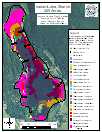Indian Lake, Sharon
Indian Lake is a private, 205-acre lake along the border between Sharon, CT and Millerton, N. The southern and eastern shores of the lake are bordered by paved roads and permanent homes while the western shore is less developed. In recent years, the invasive aquatic plant Eurasian watermilfoil (Myriophyllum spicatum) has become a major impediment to recreational use of the lake. In 2007, the milfoil weevil (Eurychiopsis lecontei) was introduced to the lake in an effort to control populations of this plant. During this introduction and the following years, frequent mapping of three milfoil species (Myriophyllum) was preformed, but it was not until 2009 that all the other species found were identified and mapped.
Our July 2009 visual survey of Indian Lake yielded twenty-two species of aquatic vegetation which included three invasives. The dominant invasive, Eurasian watermilfoil, which is also the most prevalent plant in the lake, grows to the surface in a continuous patch throughout most of the southern half of the lake in water that is one to three-meters in depth as well as a band near the eastern shore at the same depths. A similarly dense patch exists near the middle of the western shore, and sparser patches occur intermingled with other plants throughout the majority of the northern arm of the lake. Also present in the northern arm is variable-leaf watermilfoil (Myriophyllum heterophyllum) which sometimes occurs in small dense patches and at other times is mixed with other plants. The least common invasive species, curlyleaf pondweed (Potamogeton crispus), was found only as single plants growing up through mats of Eurasian watermilfoil in the southern section of the lake. Because curlyleaf pondweed is most prevalent in the spring and then dies back during the summer, substantially more of this species could have been found if our survey occurred earlier in the year.
In general, the remaining aquatic vegetation followed distinguishable patterns. The edge of the southeastern cove has dense coontail (Ceratophyllum demersum) mixed with white water crowfoot (Ranunculus longirostris), Canadian waterweed (Elodea canadensis), and flat-stemmed pondweed (Potamogeton zosteriformis). Continuing along the southern shore the mixture becomes mostly Canadian waterweed and three very similar species of broad-leafed pondweeds: white stem pondweed (Potamogeton praelongus), Richardson's pondweed (Potamogeton richardsonii), and Illinois pondweed (Potamogeton illinoensis). The southwest corner of the lake is remarkably bare, with only the floating-leafed white water lily (Nymphaea odorata)and watershield (Brasenia schreberi) along the very edge, and intermittent individual plants dotting the lake bottom. The southern half of the western shore is a mix of the same two floating-leafed species as well as Canadian waterweed and flat-stemmed pondweed, white stem pondweed, Richardson's pondweed, and Illinois pondweed. This patch abuts the large aforementioned bed of Eurasian watermilfoil.
The northern arm of the lake is characterized by a mix of the four aforementioned pondweed species (Potamogeton), eelgrass (Vallisneria americana), and Canadian waterweed occupying most of the middle of the arm that is unoccupied by milfoil. Along the edges, white water lily, watershield, floating-leaf pondweed (Potamogeton natans). and duckweed (Spirodela species) blanket the surface while many species of pondweed and bladderwort (Utricularia) grow underneath and at the edges.


